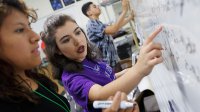3 Strategies to Get Students Talking in Math Classrooms
Talking through their math work helps students understand it better, and these strategies get those conversations started.
Your content has been saved!
Go to My Saved Content.Math teachers often focus on having students complete problems in writing, rather than talking through their thought processes. However, if students are not talking and explaining in math class, they are not truly understanding. Luckily, there are some routines that can be implemented in math classrooms to increase student voice. The routines discussed here are drawn from Principles for the Design of Mathematics Curricula: Promoting Language and Content Development, published by Stanford University’s Graduate School of Education.
We both work as instructional coaches. Prior to our work as full-time coaches, we were both classroom teachers. We have witnessed firsthand how the implementation of these routines can transform a classroom of disengaged students into engaged learners.
Routine 1: Stronger and Clearer Each Time
The purpose of Stronger and Clearer Each Time, according to Principles for the Design of Mathematics Curricula, is “to provide a structured and interactive opportunity for students to revise and refine both their ideas and their verbal and written output.”
Strategy—Successive Pair Share: This strategy is used when you want students to revise their own work. Teachers provide an equation for students to solve independently. Then, with a partner, each student shares the steps they used to reach the solution. After hearing what worked for their classmate, each student has a chance to revise their own work based on what they heard. The process continues, and the students share the new version of the equation with a new partner, get feedback, and return to editing.
In a recent trip to a geometry class, students were tackling paragraph proofs to show triangle congruence. The teacher had students engage in Successive Pair Share in order to help their proofs become more precise. As I (Rachel) watched this activity, I saw students start with a vague and incomplete proof, and through ideas from their classmates, they solidified their own ideas, which resulted in a more complete proof. I also witnessed multiple emergent multilingual students gain a better understanding of how to use the mathematical vocabulary in their writing.
Routine 2: Critique, Correct, and Clarify
This routine is used when you want students to respond to each other’s work, thoughts, and ideas.
Strategy—My Favorite No: The teacher chooses work from a student that has a commonly made error. The teacher then presents that work to the class. The first prompt from the teacher is “What is correct about this work?” The students confer in small groups to discuss places where the student’s work is correct. The teacher then asks, “What could the student have done better?” The students return to their small groups to discuss aspects of the work that could be improved. The students then have time to correctly solve the problem individually.
I (Rachel) used exit tickets at the end of each class period that asked students to reflect on material we’d covered in class that day. I would then use My Favorite No at the start of every class period to review the exit ticket from the day before. By using My Favorite No, teachers are both celebrating the learning process and reinforcing the idea that mistakes are necessary. My Favorite No is typically done anonymously. However, if there is a strong classroom culture where mistakes are highly valued, then it can be done using a student’s name.
Strategy—Always Sometimes Never: The teacher provides statements to the students, and the students decide if the statement is always, sometimes, or never true. For example:
- Linear equations have slope (sometimes).
- Linear equations have a y-intercept (sometimes).
- Linear equations have an x-intercept (sometimes).
- A point that satisfies the equation will also appear on the graph of the equation (always).
- The graph of a linear equation will travel through all four quadrants (never).
Students work in pairs or teams to decide if the statements are always, sometimes, or never true. There are a few options for implementing this strategy. All groups can be given the same statements on paper or projected using a slide. Or, each table can get a different statement and then make a Flipgrid video with an example that defends their reasoning. I (Stephanie) often support the use of Flipgrid, a recording tool that promotes social learning, in math classes.
Routine 3: Discussion Supports
The Discussion Supports routine is used, as Principles for the Design of Mathematics Curricula notes, to increase student voice by supporting “rich and inclusive discussions about mathematical ideas, representations, contexts, and strategies.”
Strategy—Revoicing: When I (Rachel) revoice during instruction, I start with the problem and review it. For the problem “Graph the line 3x + 6y = 12,” my direct instruction begins like this: “There are multiple ways to graph this line. I’m going to start by converting it into slope-intercept form. Slope intercept form is y = mx + b, so I need to isolate the y term. To do this, I’m going to subtract 3x from both sides of the equation.” Table groups then explain the process I just reviewed to one another. At this point, I expect students to say something pretty similar to what I just said. If they can’t explain it back, that is an indication that they need to ask a clarifying question of either their classmate or me.
These routines transform learning into an active process. If students are only watching their teacher do math, they are not able to explain what is happening because they are not the ones experiencing the math. When voice is increased in math, students not only become more engaged but also gain a deeper understanding of the content.
